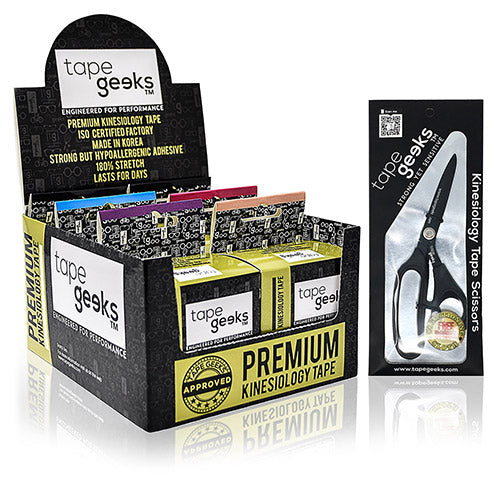
Also known as rotator cuff tendinitis, shoulder impingement is characterized by swelling and pain when the edge of your shoulder blade rubs against the rotator cuff beneath it. Since it’s a common condition among swimmers, it’s also dubbed as a swimmer’s shoulder.
Another cause can be an irritated and inflamed bursa. It is the fluid-filled sac between your tendon and acromion - it helps your tendons and muscles glide over your bones.

Shop our kinesiology tape now
Shop Now
Another common cause is poor posture. Often characterized by rounded shoulders and a hunched position, it predisposes you to impingement. If you’re sitting at a desk, using your computer, playing a video game, or reading, a forward head can also be observed. This predisposes you to shoulder impingement and pain.

What are the symptoms of shoulder impingement?
The symptoms for shoulder impingement include:
- Pain in the shoulder when you’re reaching overhead
- Pain when reaching behind your back
Do you suffer from shoulder impingement and are looking to improve your posture? If your answer is yes, read on!
Here, we’ll show you a kinesiology taping protocol that will help offload the structures that are getting impinged, swollen, or inflamed. Learn how to correct your posture to prevent shoulder impingement that eventually leads to pain.
What’s the kinesiology taping protocol for shoulder impingement?
- First, measure and cut your kinesiology tape spanning the length of the deltoid muscle up until the base of the neck. Round your edges. Make sure to use high-quality gum-free scissors for easy cutting! ;)
- Start by applying the anchor with 0% tension on the tape. Next, have the patient raise his arms to the side and position the tape parallel to the patient’s arm without applying the kin tape yet.
- To apply a 50% tension on the tape, slowly have the patient lower his arm while applying the tape alongside his movement. Apply the end of the tape without any tension.
- Rub the tape to activate the adhesive.

How do you improve your posture through shoulder correction?
Now, we’re taking the protocol further to improve posture. This technique will cue the patient to straighten his back and will not restrict his movement. The tension on the tape will also cue the muscles to stay in the right posture when it tends to revert to its old position.
- To help with the patient’s posture if he’s got rounded shoulders, you need another strip of kinesiology tape. Measure from the front of the shoulder up until the back of the shoulder blade. Round your tape ends.
- Position the kinesiology tape starting on the front of the shoulder, and apply the anchor without any tension.
- Then, straighten the patient’s back before applying the therapeutic zone with a 50% tension. Make sure to NOT apply any tension to the ends.
- Rub the tape to activate the adhesive.
Make sure that you avoid skin rash and irritation when applying kinesiology tape with Tape Geeks’ skin-friendly tapes. Try us out today!
Use code: BETTERPOSTURE for 20% OFF YOUR FIRST ORDER

Shop our bundles now
Shop NowWhat is manual tissue gliding?
Manual tissue gliding uses the hands to act as the tape to give an idea of which direction to apply the tape before using it. Try out several directions to determine which direction gives the most benefit to the patient before you start taping.
How do you use manual tissue gliding to help with pain?
In this protocol, we’ll be demonstrating the Y-cut. Follow the protocol above and follow the instructions below to help with the pain.
- Measure the tape again and round off the edges. Then, make a Y-cut. Round off the edges. Always remember that the tape will always stick better on the skin. Put 0% tension on the anchor.
- With the two other strips, put 20% tension upon application.
- Rub the tape to activate the adhesive.
To get the best deals from Tape Geeks, visit our Amazon store today!

Shop our collection now
Shop NowSubscribe to the TapeGeeks Newsletter for new videos, discounts and more!Join The Geeks Club









